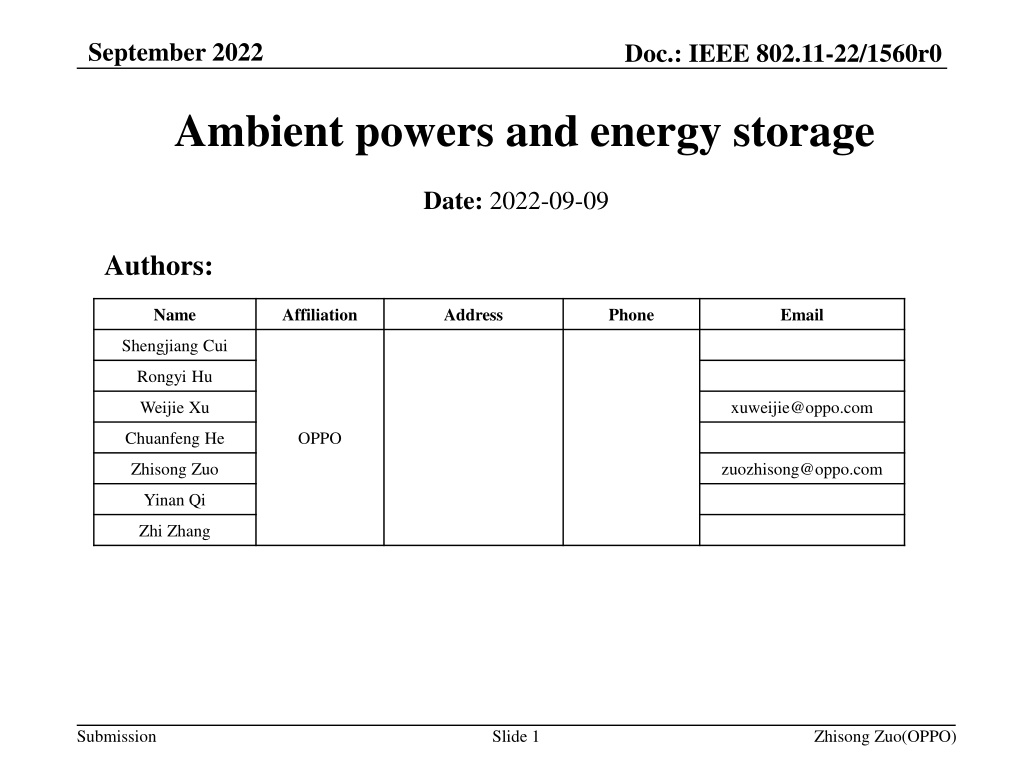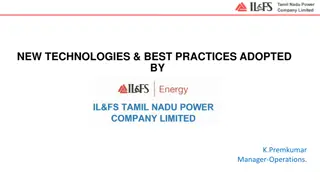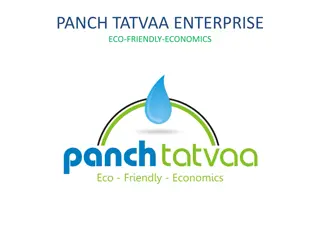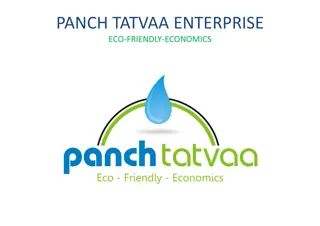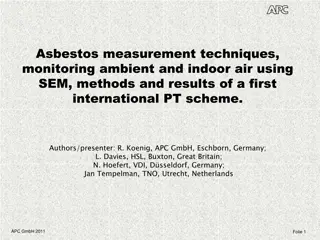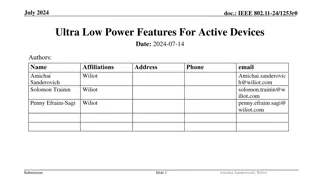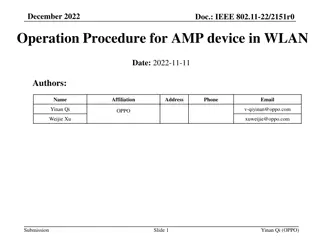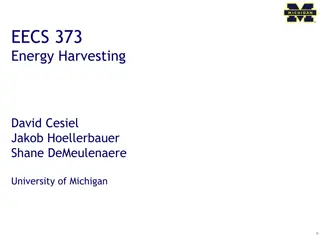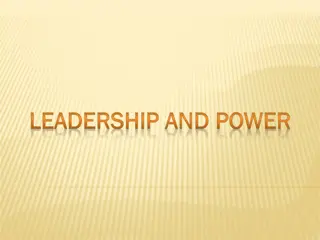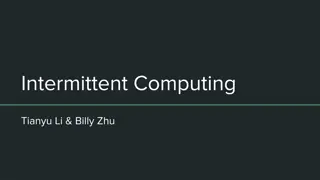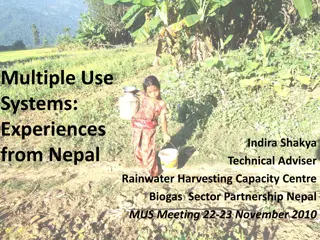Ambient Power Harvesting Technologies Overview
This document discusses various ambient power harvesting technologies such as RF energy, solar power, light, and thermal energy. RF-based energy harvesting utilizes radio waves for power transmission with potential applications in logistics, smart homes, and environmental monitoring. Solar power offers a clean and abundant energy source with varying power densities based on environmental conditions. Indoor lighting can also be harnessed for energy needs. Additionally, thermal energy from temperature differentials finds application in outdoor monitoring and agricultural sectors. Each technology presents unique advantages and challenges in energy conversion efficiency and power density.
Download Presentation

Please find below an Image/Link to download the presentation.
The content on the website is provided AS IS for your information and personal use only. It may not be sold, licensed, or shared on other websites without obtaining consent from the author.If you encounter any issues during the download, it is possible that the publisher has removed the file from their server.
You are allowed to download the files provided on this website for personal or commercial use, subject to the condition that they are used lawfully. All files are the property of their respective owners.
The content on the website is provided AS IS for your information and personal use only. It may not be sold, licensed, or shared on other websites without obtaining consent from the author.
E N D
Presentation Transcript
September 2022 Doc.: IEEE 802.11-22/1560r0 Ambient powers and energy storage Date: 2022-09-09 Authors: Name Affiliation Address Phone Email Shengjiang Cui Rongyi Hu Weijie Xu xuweijie@oppo.com Chuanfeng He OPPO Zhisong Zuo zuozhisong@oppo.com Yinan Qi Zhi Zhang Submission Slide 1 Zhisong Zuo(OPPO)
September 2022 Doc.: IEEE 802.11-22/1560r0 Outline Ambient power and energy harvesting Energy storage Summary Reference Submission Slide 2 Zhisong Zuo(OPPO)
September 2022 Doc.: IEEE 802.11-22/1560r0 Ambient power (1) - RF energy RF-based transmission of radio waves ranging from 3 kHz to 300 GHz, it be accomplished using a single- stage or multistage converter. The amount of harvestable power depends on the source power, antenna gain, and the distance from the RF source. energy harvesting uses the Figure 1:Rectifier circuit for RF Energy Ambient RF energy has a relatively low energy density and the conversion efficiency depends on the received power level, as in Table 1. Table 1: Conversion efficiency for RF Energy [3] The main advantage of RF-based energy harvesting is its environments and controllable (e.g., can send power with a transmitter). Potential applications include logistics/warehouse, smart homes, health environmental monitoring etc. availability in indoor manufacturing, monitoring, and The minimum RF power can be harvested is around -30dB. [1][2] Submission Slide 3 Zhisong Zuo(OPPO)
September 2022 Doc.: IEEE 802.11-22/1560r0 Ambient power (2) - Solar energy/light Solar power/light can be transformed into electrical power using photovoltaic cells and it uses photovoltaic effect for energy harvesting with conversion efficiency of 10-40%[4]. Solar energy For the outdoor case, solar energy is one of the most common ambient power, it can supply inexhaustible clean energy and has high power density of up to 100 mW/cm2[5]. Solar power is unstable, not constant and not continuous. It is highly dependent on the atmospheric condition, surrounding structures, etc. It is available during daylight hours. and inefficient on a cloudy day or at night. Used for outdoor environmental monitoring, agriculture, husbandry, transportation etc.. Light For the indoor cases, light from the Lighting Equipment can be used. Although the power density is lower than solar, 100uw/cm2, it is much stable and controllable. Used environmental monitoring etc. for manufacturing, indoor Figure 2: The equivalent electrical circuit of a single diode solar PV cell [6] Submission Slide 4 Zhisong Zuo(OPPO)
September 2022 Doc.: IEEE 802.11-22/1560r0 Ambient power (3) - Thermal energy Thermal energy is another ambient power source that are available for lots of cases. Electrical power is directly generated by exploiting the temperature difference in thermoelectric devices taking advantage of thermoelectric effects, such as the Seebeck effect or the Thomson effect. Thermoelectric generators have low efficiency (only about 5 6%) [7]. The power density is 25~1000uw/cm2 depending the environment condition. Thermal energy can be used in many outdoor applications or indoor case, as long as temperature difference or temperature fluctuation can be expected in the environment. For example, outdoor environmental monitoring, agriculture, husbandry. Figure 3: Seebeck effect Submission Slide 5 Zhisong Zuo(OPPO)
September 2022 Doc.: IEEE 802.11-22/1560r0 Ambient power (4) - Piezoelectric power The piezoelectric effect generates electrical voltages or currents from mechanical strains, such as vibration or deformation. Typical piezoelectric-based energy harvesters keep creating power when there is a continuous mechanical motion, such as acoustic noises and wind, or they sporadically generate power for intermittent strains, such as human motion (walking, clicking a button, etc.). The volume of the piezoelectric power generators is relatively small and light and typical output power density values of usual piezoelectric materials are around 250 W/cm3 but they can create more power when a motion or deformation is intense [8-9]. Figure 4: The piezoelectrochemical process that occurred at the surface/interface between the siloxene electrode and siloxene PVDF piezofiber [10] Figure 5: Piezoelectric energy harvesting generator[11] Submission Slide 6 Zhisong Zuo(OPPO)
September 2022 Doc.: IEEE 802.11-22/1560r0 Summary of ambient power The typical power from ambient power source is summarized as in following table2: Table 2. Energy harvesting sources [12-14]. Energy Source Application Environment Energy Conversion Factors Method Power Density Feature Advantages Disadvantages 0.1 10 W/cm2 (Artificial) Source transmission power; Distance from source; Antenna gain; Antenna design; Ambient or dedicated techniques; High conversion efficiency; Available anywhere; (Semi-)urban environments; Dedicated transmitter setup; Requires tuning to frequency bands; Energy availability limited by safety; Distance dependent; Low-power density Radio Frequency Partly controllable Partly predictable Antenna 0.001(WiFi)~0.1(GSM) W/cm2 10~100 mW/cm2 (Outdoor Sun Light) Long periods of natural absence; Natural prediction limited; Unavailable at night and non- controllable; Natural light; Brightly lit indoor spaces; Light intensity; Temperature gradient; Material properties; High voltage output Predictable; Low fabrication costs Uncontrollable Predictable Solar Photovolatic 10~100 W/cm2 (Indoor Art. Light) Spatial temperature gradient; Temporal temperature gradient; Cycle frequency; Industrial waste heat; Household water; Domestic heaters; Body heat; Long life due to stationary parts; High reliability; Requires constant thermal gradient; Low conversion efficiency; Performs poorly on small gradients; Uncontrollable Predictable Thermal Thermoelectric 20~60 W/cm2 High-output currents; Robustness; Low-cost design; Controllable Relatively large size; Unpredictable; 300-800 W/cm3 Electromagnetic Industrial machinery; transportation; Human activity; Roads and infrastructure; High-output voltage; Possibility to build low- cost devices Mechanical Vibration Vibration frequency; Vibration acceleration; Requires bias voltage; Unpredictable 50-100 W/cm3 Electrostatic Partly controllable High voltage output High power density; Simplicity design and fabrication Highly variable output; Unpredictable; 4-250 W/cm3 Piezoelectric It can be observed the output power harvested from various power sources is very limited, e.g. from 1uW to 100mW(per cm2/cm3). Submission Slide 7 Zhisong Zuo(OPPO)
September 2022 Doc.: IEEE 802.11-22/1560r0 Energy storage for AMP IoT Characteristics of ambient power For typical ambient power, it can be observed the power harvested is very limited, e.g. from 1uW to 100mW(per cm2/cm3). For some ambient power from artificial power source(e.g., light, RF waves), the power can be stable and constant. But for some other kind of ambient power such as solar, heat or vibration, the ambient power will be unstable (intermittent, not constant). It is impossible to use the ambient power as a direct power source for electronic devices. Energy storage element is needed for some AMP IoT devices The energy storage element is able to stabilize and control the power output, smooth the fluctuation. It is able to collect the weak harvested power (e.g., in the level of micro ampere or even nano ampere ) and provide the required peak discharge current for the AMP IoT devices. Therefore, it make it possible to use more kinds of ambient power sources for AMP IoT by using the energy storage element. Note: It is still necessary to have no power storage for some types of AMP IoT devices. Submission Slide 8 Zhisong Zuo(OPPO)
September 2022 Doc.: IEEE 802.11-22/1560r0 Possible Energy storage elements for AMP IoT Capacitor and solid state battery can be considered as the possible energy storage elements for AMP IoT devices. Limited but appropriate/sufficient power storage capacity for AMP IoT devices. - With a capacitor of 24uF, if it is fully charged, it can drive the AMP IoT devices for 3.6 seconds (1.5V and 10uA are assumed). 24uF*1.5V= 36uC = 36 uAs - With a solid state battery of 1uAh@1.5V, it can drive the AMP IoT devices for 6 minutes (1.5V and 10uA are assumed). Good characteristics such as wide working temperature range, especially using solid state battery, as shown in Table 3. Table 3 Comparison of capacitor, solid state battery and legacy coin battery Legacy coin battery Solid state battery Capacitor Capacity 1~500mAh 10uF~100uF 0.05~5 Cycling Capacity 500~1000 >10000 >1000 Temperature Range ( ) -20 ~ +60 -40 ~ +85 -40 ~ +105 Self-discharging Security Submission Slide 9 Zhisong Zuo(OPPO)
September 2022 Doc.: IEEE 802.11-22/1560r0 Summary In this contribution, we discuss the following on ambient power: The possible ambient power sources The power density and its characteristics of four typical ambient power The example use cases for each ambient power The necessity of power storage Example energy storage elements for AMP IoT and the corresponding characteristics Submission Slide 10 Zhisong Zuo(OPPO)
September 2022 Doc.: IEEE 802.11-22/1560r0 4. Reference [1] Noghabaei S M, Radin R L, Savaria Y, et al. A high-efficiency ultra-low-power CMOS rectifier for RF energy harvesting applications[C]//2018 IEEE International Symposium on Circuits and Systems (ISCAS). IEEE, 2018: 1-4 [2] Wu Z, Zhao Y, Sun Y, et al. A Self-Bias Rectifier with 27.6% PCE at-30dBm for RF Energy Harvesting[C]//2021 IEEE International Symposium on Circuits and Systems (ISCAS). IEEE, 2021: 1-5. [3] Valenta C R, Durgin G D. Harvesting wireless power: Survey of energy-harvester conversion efficiency in far-field, wireless power transfer systems[J]. IEEE Mi crowave Magazine, 2014, 15(4): 108-120. [4] Kim S, Vyas R, Bito J, et al. Ambient RF energy-harvesting technologies for self-sustainable standalone wireless sensor platforms[J]. Proceedings of the IEEE, 2014, 102(11): 1649-1666. [5] Green M, Dunlop E, Hohl Ebinger J, et al. Solar cell efficiency tables (version 57)[J]. Progress in photovoltaics: research and applications, 2021, 29(1): 3-15. [6] Mishu M K, Rokonuzzaman M, Pasupuleti J, et al. An adaptive TE-PV hybrid energy harvesting system for self-powered iot sensor applications[J]. Sensors, 2021, 21(8): 2604. [7] Prauzek M, Konecny J, Borova M, et al. Energy harvesting sources, storage devices and system topologies for environmental wireless sensor networks: A review[J]. Sensors, 2018, 18(8): 2446. [8] Kim S, Vyas R, Bito J, et al. Ambient RF energy-harvesting technologies for self-sustainable standalone wireless sensor platforms[J]. Proceedings of the IEEE, 2014, 102(11): 1649-1666. [9] H. S. Kim, J. -H. Kim, and J. Kim, A review of piezoelectric energy harvesting based on vibration, Int. J. Precision Eng. Manuf., vol. 12, no. 6, pp. 1129 1141, Dec. 2011. [10] Krishnamoorthy K, Pazhamalai P, Mariappan V K, et al. Probing the energy conversion process in piezoelectric-driven electrochemical self-charging supercapacitor power cell using piezoelectrochemical spectroscopy[J]. Nature communications, 2020, 11(1): 1-11. [11] Hoang T, Ferin G, Bantignies C, et al. Aging assessment of piezoelectric energy harvester using electrical loads[C]//Journal of Physics: Conference Series. IOP Publishing, 2019, 1407(1): 012078. Submission Slide 11 Zhisong Zuo(OPPO)
September 2022 Doc.: IEEE 802.11-22/1560r0 4. Reference [12] Williams A J, Torquato M F, Cameron I M, et al. Survey of energy harvesting technologies for wireless sensor networks[J]. IEEE Access, 2021, 9: 77493-77510. [13] Mishu M K, Rokonuzzaman M, Pasupuleti J, et al. Prospective efficient ambient energy harvesting sources for iot-equipped sensor applications[J]. Electronics, 2020, 9(9): 1345. [14] Sanislav T, Mois G D, Zeadally S, et al. Energy harvesting techniques for internet of things (IoT)[J]. IEEE Access, 2021, 9: 39530-39549. Submission Slide 12 Zhisong Zuo(OPPO)
